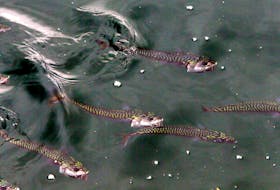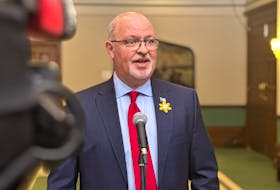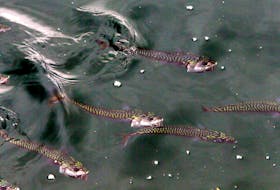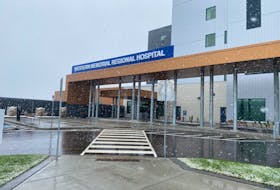“Just to see that alone is amazing,” he said, steaming his small boat — the kind you might use for whale watching — away from the Hebron topsides after local media and politicians were given a good look Friday.
The top half of the Hebron facility is parked for now on the dock at Mosquito Cove. The topsides is scheduled to be “mated” with the floated base of the structure in early 2017, with a target for tow-out of the completed production facility, to its home in the Hebron oilfield, around the middle of next year.
RELATED STORY:
First oil production is also expected in 2017.
“It’s pretty impressive, I got to say,” Penney said of the assembled topsides — a combination of the completed living quarters, the derrick equipment set, utilities process module (its 35,000 tonnes was towed past St. John’s in early September), the helideck, flare boom, lifeboats and more. Electrical and other connections are being completed inside.
A close view of the topsides is not usually part of his runs. He ferries workers to the flotilla around the floated Hebron base and back. The McKeil Marine team, including Penney, made 57,472 one-way trips to the end of September, moving a total of 1,431,227 passengers. At the peak of the concrete work, shift changes meant load-and-go for the ferrymen.
Worker numbers have dropped off since then.
Hebron’s senior manager, Geoff Parker, said over 3,500 people were working on the project in the third quarter. The focus for the project team is on those significant tasks still ahead, he said, referring to the mating and tow-out of the facility.
On employment numbers, he said the next phase of the project will bring its own benefits.
“The ongoing operation, it’ll provide jobs for 20, 30 years. That’ll all be coming onstream,” he said.
Offshore, the living quarters will house about 220 people. More people will be employed onshore in operations and in related supply and service work.
But thousands of tradespeople will not all find a place there.
Having requested the site tour, Natural Resources Minister Siobhan Coady said she was struck by the sheer size of the undertaking, its complexity and the feat of engineering achieved to date. She congratulated the project team on, as Parker noted, reaching a safety statistic of 35 million person hours of project work without a lost-time injury.
But she could not say where the bulk of tradespeople who have worked on the project might be drawn next.
Coady did say the Liberals are pushing to find a way to ease the boom-and-bust cycle in the province’s oil sector.
“I think that’s a very important question,” she said. “How do we get to this — we don’t have the peaks and valleys, we get to some stability in the industry?”
Next steps include establishing the oil and gas industry development council and, Coady said, finding ways to — for one — connect more local supply and service companies with international players, seeking opportunities that might help bridge the gap and even expand existing businesses. She said she will also look for advice on shortening the project development timelines.
Looking ahead, she said the sector and the province have the continuing possibility of a development by Husky Energy of its next White Rose step-out, a potential development down the line by Statoil in the Flemish Pass and a potential bump in exploration in the Orphan Basin.
However, as with local jobs in the trades after the current megaproject, nothing is guaranteed.
“Just to see that alone is amazing,” he said, steaming his small boat — the kind you might use for whale watching — away from the Hebron topsides after local media and politicians were given a good look Friday.
The top half of the Hebron facility is parked for now on the dock at Mosquito Cove. The topsides is scheduled to be “mated” with the floated base of the structure in early 2017, with a target for tow-out of the completed production facility, to its home in the Hebron oilfield, around the middle of next year.
RELATED STORY:
First oil production is also expected in 2017.
“It’s pretty impressive, I got to say,” Penney said of the assembled topsides — a combination of the completed living quarters, the derrick equipment set, utilities process module (its 35,000 tonnes was towed past St. John’s in early September), the helideck, flare boom, lifeboats and more. Electrical and other connections are being completed inside.
A close view of the topsides is not usually part of his runs. He ferries workers to the flotilla around the floated Hebron base and back. The McKeil Marine team, including Penney, made 57,472 one-way trips to the end of September, moving a total of 1,431,227 passengers. At the peak of the concrete work, shift changes meant load-and-go for the ferrymen.
Worker numbers have dropped off since then.
Hebron’s senior manager, Geoff Parker, said over 3,500 people were working on the project in the third quarter. The focus for the project team is on those significant tasks still ahead, he said, referring to the mating and tow-out of the facility.
On employment numbers, he said the next phase of the project will bring its own benefits.
“The ongoing operation, it’ll provide jobs for 20, 30 years. That’ll all be coming onstream,” he said.
Offshore, the living quarters will house about 220 people. More people will be employed onshore in operations and in related supply and service work.
But thousands of tradespeople will not all find a place there.
Having requested the site tour, Natural Resources Minister Siobhan Coady said she was struck by the sheer size of the undertaking, its complexity and the feat of engineering achieved to date. She congratulated the project team on, as Parker noted, reaching a safety statistic of 35 million person hours of project work without a lost-time injury.
But she could not say where the bulk of tradespeople who have worked on the project might be drawn next.
Coady did say the Liberals are pushing to find a way to ease the boom-and-bust cycle in the province’s oil sector.
“I think that’s a very important question,” she said. “How do we get to this — we don’t have the peaks and valleys, we get to some stability in the industry?”
Next steps include establishing the oil and gas industry development council and, Coady said, finding ways to — for one — connect more local supply and service companies with international players, seeking opportunities that might help bridge the gap and even expand existing businesses. She said she will also look for advice on shortening the project development timelines.
Looking ahead, she said the sector and the province have the continuing possibility of a development by Husky Energy of its next White Rose step-out, a potential development down the line by Statoil in the Flemish Pass and a potential bump in exploration in the Orphan Basin.
However, as with local jobs in the trades after the current megaproject, nothing is guaranteed.








